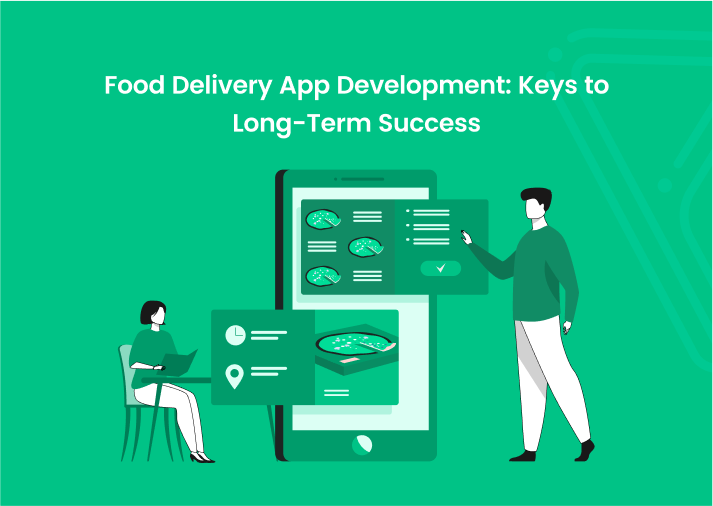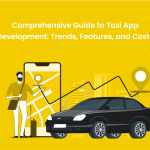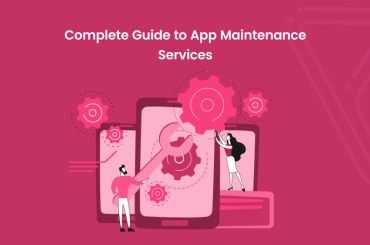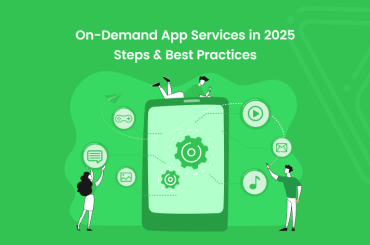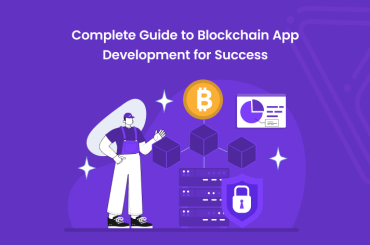Food delivery app development makes ordering meals quick and convenient, benefiting both customers and businesses. A well-designed app enhances user experience and drives growth.
Partnering with a Mobile App Development Company in Chennai ensures a seamless, feature-rich platform tailored to your needs, helping you attract more customers and stay ahead in the competitive food delivery market.
What is Food Delivery App Development?
Food delivery app development is about creating an app that helps customers, restaurants, and delivery drivers connect. It lets customers order food, pay, and track their orders easily.
The app helps customers choose food, place orders, and see when their food will arrive. Restaurants get the orders, make the food, and drivers deliver it on time.
Why Build a Food Delivery App?
- Increased Reach and Higher Revenue
Food delivery apps help restaurants reach more people in different areas. This can lead to more customers and higher sales. - Eliminates Entry Barriers
These apps make it easier for small businesses to start offering delivery. They provide a ready platform, so restaurants don’t need to spend much money upfront. - Unmatched Convenience for Consumers
Food delivery apps make it easy for customers to order food anytime and from anywhere. Customers don’t have to leave home, making it very convenient. - Personalized User Experience
Food delivery apps suggest meals based on what customers like or have ordered. This helps customers quickly find food they enjoy. - Increased User Engagement
Push notifications, rewards, and special deals keep users interested and encourage them to order more. - Predictive Analytics
Food delivery apps use data to predict what customers will order. This helps restaurants improve delivery times and manage orders better.
6 steps To Build a Successful Food Delivery App
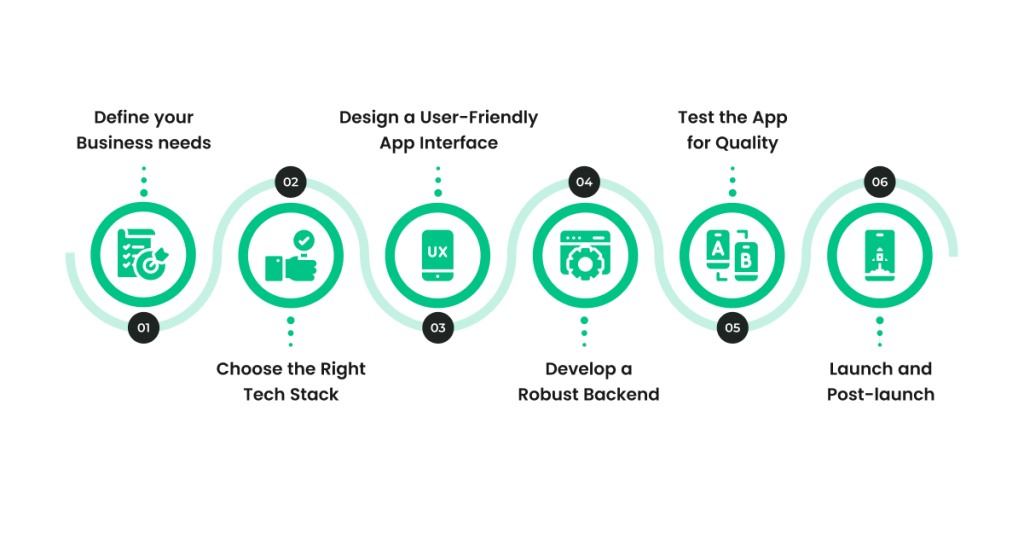
Step 1: Define Your Business Needs
Start by defining your business needs. This includes understanding your target audience, key features, and business model.
- Target Audience: Know who will use your app, like workers, students, or families.
- Key Features: Decide on features like order tracking, payment options, and restaurant menus.
- Business Model: Choose whether to charge restaurants, offer subscriptions, or add delivery fees.
Step 2: Choose the Right Tech Stack
Choosing the right technology is key to mobile app success. iOS App Development requires the best platforms, frameworks, and tools for performance and scalability.
- Mobile Platforms: Decide if your app will be on iOS, Android, or both.
- Backend Framework: Choose technology to store data and handle user requests.
Tools and Technologies Used for Food Delivery App Development
| Category | Tools & Technologies | Description |
|---|---|---|
| Frontend Development | Android App Development, Flutter App Development, iOS App Development | Android App Development uses Java/Kotlin, while Flutter App Development enables cross-platform apps. iOS App Development focuses on Swift/Objective-C. |
| Backend Development | Node.js, Django, Ruby on Rails, Laravel | Frameworks for handling data, APIs, and app logic. |
| Database | MongoDB, MySQL, PostgreSQL, Firebase | Databases to store app data. MongoDB is NoSQL, and MySQL and PostgreSQL are relational. |
| Payment Integration | Stripe, PayPal, Razorpay, Braintree | Tools for secure payments in the app. |
| Real-Time Updates | Firebase, Pusher, Socket.io | Technologies for live order tracking and updates. |
| Location Tracking | Google Maps API, Mapbox | Used for GPS-based delivery and restaurant tracking. |
| Push Notifications | OneSignal, Firebase Cloud Messaging (FCM) | Services for sending updates and offers to users. |
| Cloud Services | AWS, Google Cloud, Microsoft Azure | Cloud platforms for hosting and scaling the app. |
| Security | SSL/TLS, JWT, OAuth2 | Protocols to encrypt data and manage authentication. |
| Analytics | Google Analytics, Mixpanel, Firebase Analytics | Tools for tracking user behavior and app performance. |
Step 3: Design a User-Friendly App Interface
The app’s design should be simple and easy to use. A clean layout will keep users happy.
- Simple Navigation: Make it easy for users to browse restaurants and order food.
- Clear Buttons: Make the buttons for ordering and paying easy to click.
- Fast Loading: Ensure the app loads quickly so users don’t wait.
Step 4: Develop a Robust Backend
A strong backend keeps your app running smoothly.
- Real-time Updates: Make sure orders update quickly for customers and restaurants.
- Data Storage: Safely store customer information and orders.
- Scalability: The backend should grow as the number of users increases.
Step 5: Test the App for Quality
Testing your app is important.
- Beta Testing: Let real users test the app and provide feedback.
- UI/UX Testing: Ensure the app is easy to use and looks good.
- Performance Testing: Test how the app works when many people use it simultaneously.
Step 6: Launch and Post-launch Support
After launching, provide ongoing support for your app.
- User Feedback: Listen to user feedback and fix any issues.
- Bug Fixes: Regularly update the app to fix bugs.
- Feature Enhancements: Add new features based on user requests.
Benefits of Food Delivery Mobile App Development
- Better Customer Satisfaction
Customers can order food easily, anytime and anywhere, making it more convenient. - Faster Service
Orders are processed quickly, helping restaurants reduce wait times and errors. - Reach More Customers
Apps help restaurants connect with customers in different areas and grow their business. - Loyalty Building
Offers, rewards, and special deals make customers want to return. - Fits with Popular Trends
These apps help businesses meet the demand for quick, on-demand services, allowing restaurants to grow.
Challenges in Building a Food Delivery App
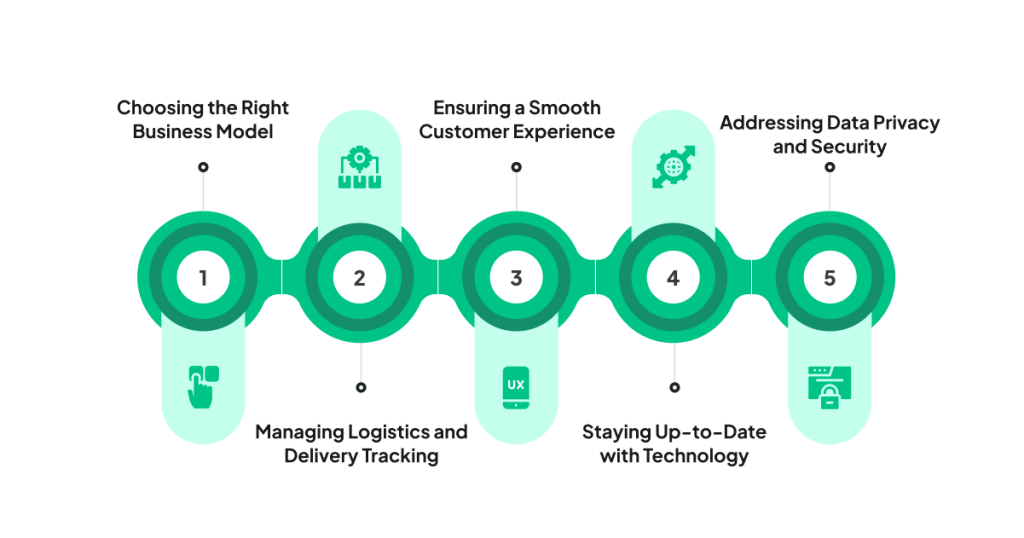
Choosing the Right Business Model:
There are three main types:
- Commission-based: Restaurants pay a fee per order. Pros: Easy. Cons: Expensive.
- Subscription-based: Customers pay a set amount for unlimited orders. Pros: Steady income. Cons: It might not attract all customers.
- Delivery Charge-based: Customers pay extra for delivery. Pros: Clear. Cons: Extra costs may turn people away.
Managing Logistics and Delivery Tracking
It’s hard to manage routes and track orders. You need to ensure orders arrive on time and drivers are organized.
Ensuring a Smooth Customer Experience
The app should be easy to use. Fast delivery, simple navigation, and helpful support make customers happy.
Staying Up-to-Date with Technology
New techs like AI and IoT can help. AI can improve routes, and IoT helps manage deliveries. Keeping up with new tech is important.
Addressing Data Privacy and Security
Keep customer information safe. Use secure payment methods and follow privacy rules to build trust.
Examples of Successful Food Delivery Apps
- Swiggy
Swiggy uses Python, Java, and React. It focuses on quick deliveries and great customer service, helping it grow fast. - Zomato
Zomato uses Node.js, Java, and AWS. It stands out with a large restaurant network and food discovery features. - Dunzo
Dunzo uses Flutter and Node.js. It offers fast delivery for food and other errands, making it unique.
How a Delivery App Works: The Complete Process
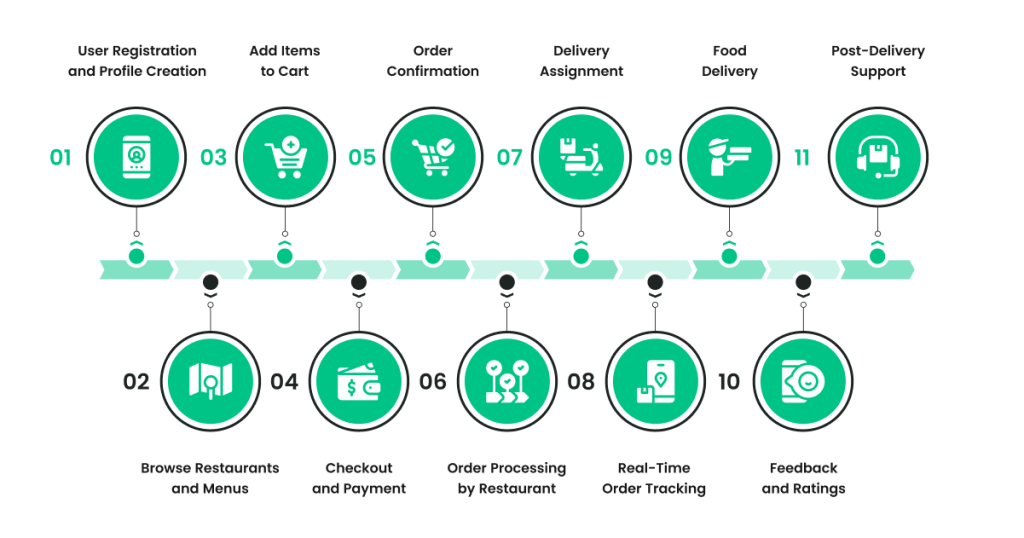
- User Registration and Profile Creation
Users sign up with their basic details to set up their accounts. - Browse Restaurants and Menus
Users look for restaurants and explore their menus. - Add Items to Cart
Users select food and can customize their order. - Checkout and Payment
Customers review their orders and pay using available options. - Order Confirmation
The app confirms the order, and the restaurant gets the details. - Order Processing by Restaurant
The restaurant prepares the food and notifies us when it is ready. - Delivery Assignment
Delivery drivers are assigned based on location and availability. - Real-Time Order Tracking
Customers can track their orders and get delivery updates. - Food Delivery
The driver delivers the food to the customer. - Feedback and Ratings
After receiving the food, customers leave ratings and feedback. - Post-Delivery Support
Customer service handles any issues after delivery.
Must-Have Features for Every Food Delivery App
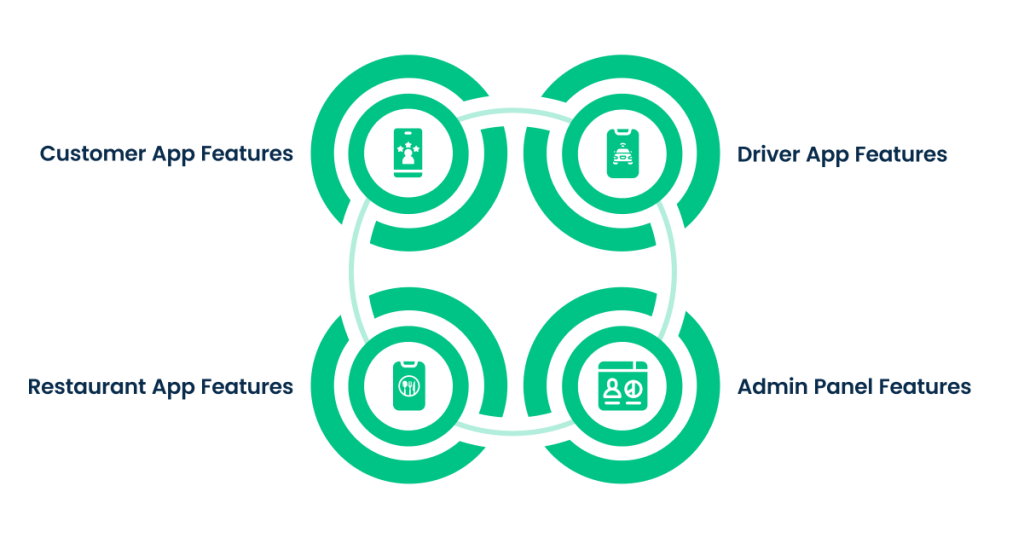
- Customer App Features
Easy navigation, profiles, order history, notifications, and payment options. - Driver App Features
Real-time tracking, route guidance, delivery updates, and customer contact. - Restaurant App Features
Order management, inventory tracking, payment handling, and reports. - Admin Panel Features
Order overview, customer management, restaurant data, and analytics.
How We Help You Build a Scalable, Profitable Food Delivery App
- Custom Features
We make the app fit your business needs with special features. - Third-Party Integration
We add payment systems, tracking, and analytics tools to improve the app. - Scalability
The app will grow with your business, handling more users and orders. - User-Friendly Design
We focus on making the app easy for customers and drivers to use. - Business Focus
We help you run the app smoothly and make your business more profitable.
Why Food Delivery Apps Are the Future of the Food Industry
- The Rise of Online Food Delivery Services
After the pandemic, online food orders became more popular. Many people now prefer delivery over dining out. - Consumer Behavior and Convenience
Food apps make life easier by offering many choices in one place. Ordering is quick and hassle-free. - Market Growth and Investment Opportunities
The food delivery business is growing fast. Investors are funding new ideas to make it even better.
Food Delivery App Development Cost Breakdown
| Factors | Description | Estimated Cost Range (USD) |
|---|---|---|
| Features and Functionalities | Basic features cost less; advanced ones like tracking or AI recommendations cost more. | $10,000 – $50,000+ |
| Tech Stack | It depends on platforms (iOS, Android, or both) and tools like Flutter or React Native. | $5,000 – $20,000+ |
| App Complexity | Simple apps are cheaper; complex apps with integrations cost more. | $15,000 – $100,000+ |
| Development Team Location | Rates vary by region, with North America costing more than Asia or Europe. | $20 – $150/hour |
| UI/UX Design | Basic designs are cheaper; custom, advanced designs cost more. | $3,000 – $15,000+ |
| Testing and QA | Ensure smooth performance and bug-free functionality. | $2,000 – $10,000+ |
| Post-launch Support | Covers updates and app maintenance after launch. | $1,000 – $5,000+/month |
Revenue Models for Modern Food Delivery Apps
- Commissions
Apps earn by charging restaurants a fee for every order placed. - Subscription
Users pay monthly or yearly fees for perks like free delivery and special offers - Paid Advertisements
Restaurants and brands pay to promote themselves within the app. - Delivery and Extra Charges
Delivery fees for faster or special services add to the revenue.

Conclusion
Food delivery apps streamline the process for people to order food and help businesses grow. By focusing on the right features, food delivery app development can help you create a successful app.
At Pyramidion Solutions, we specialize in food delivery app development. Our team builds simple, effective apps that fit your business needs and grow with you.
Get started today! Contact Pyramidion Solutions to turn your food delivery app idea into a success!
FAQ(Frequently Asked Questions)
1. What is food delivery app development?
It’s the process of building an app where users can order food from restaurants and get it delivered.
2. How can a food delivery app benefit my business?
It assists in expanding your customer base, increasing revenue, and engaging users.
3. What are the key features needed for a food delivery app?
Important features include easy sign-up, restaurant search, order tracking, and secure payment options.
4. How much does it cost to develop a food delivery app?
The cost depends on the features and complexity of the app.
5. Why should I choose Pyramidion Solutions for food delivery app development?
We create custom, easy-to-use apps that grow with your business.

As the Director of Business Development, I have provided top-notch IT solutions for over a decade for software development, mobile application development, and blockchain development. My main work and passion lie in contributing to the business’s success through knowledge, creativity, hard work, and strong organizational skills.

